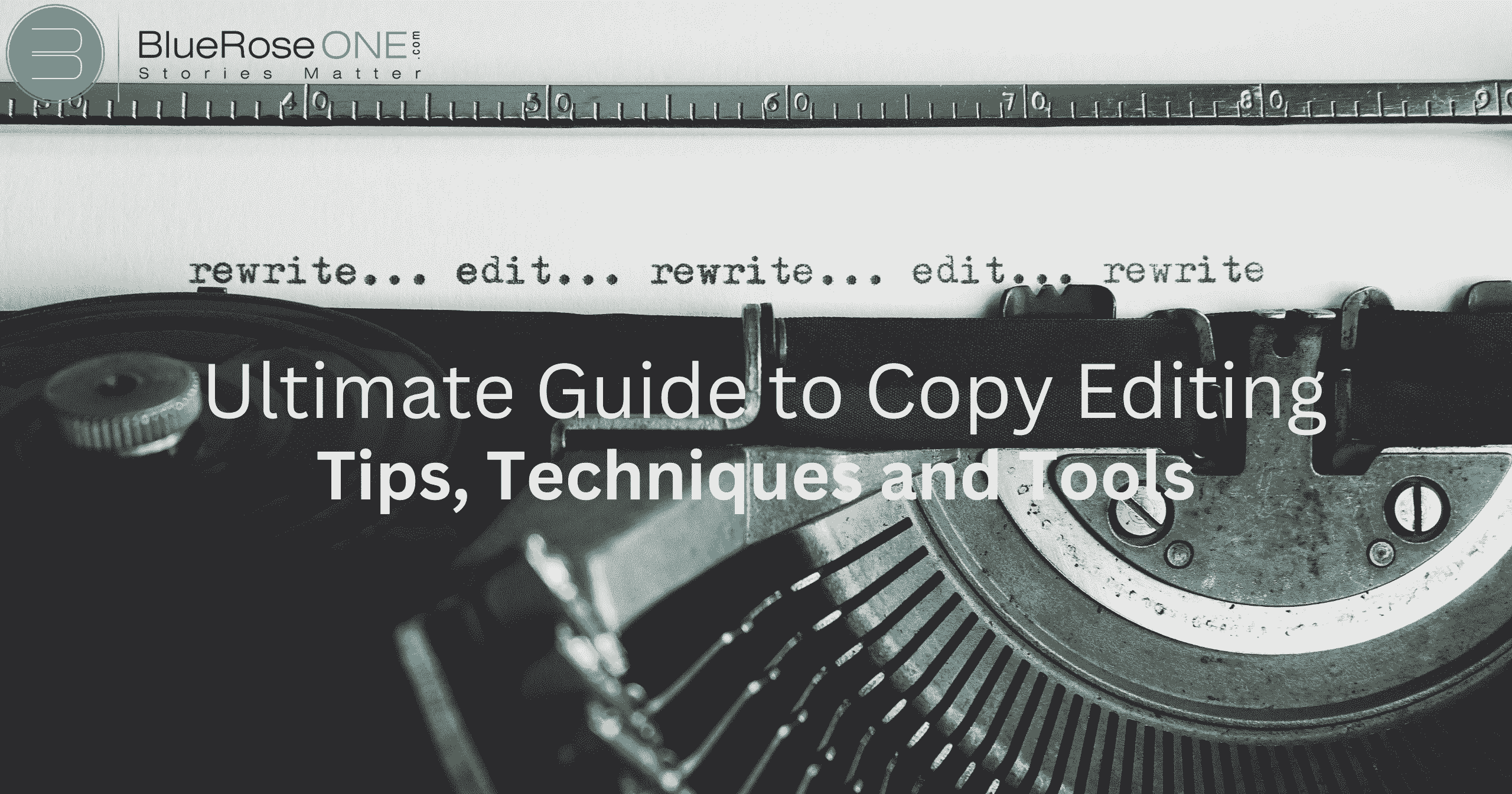Introduction to Copyediting
In order to ensure written materials are clear, consistent, and professional, copy editing is a critical stage in the content development process that is frequently overlooked. An article, blog post, or piece of marketing collateral can all benefit greatly from careful copy editing in terms of quality and impact.
Understanding the Basics of Copy Editing
Fundamentally, copy editing is the process of identifying and fixing mistakes in spelling, grammar, punctuation, and style. It guarantees that the text follows accepted linguistic norms and keeps a steady tone and voice throughout.
You may also like: A Guide for Aspiring Book Authors: Know the Publishing World
Tips for Effective Copy Editing
To become proficient in copy editing, it’s essential to develop a keen eye for detail and a systematic approach to reviewing content. Here are some tips to help you become a more effective copy editor:
Develop a keen eye for detail: Gaining an acute sense of detail is essential when working with copy editing. To guarantee coherence and clarity, it entails carefully examining each word, punctuation, and formatting selection. By developing this ability, editors can improve the written content’s quality by identifying even the smallest mistakes.
Take breaks between editing sessions: This is a crucial mantra for effective copy editing. Stepping away allows for fresh eyes and a renewed perspective. Whether it’s a brief stroll or a cup of tea, these breaks rejuvenate your focus, leading to sharper edits and a polished final product.
Read aloud to catch errors: A key component of efficient copy editing is this straightforward yet effective method. Reading aloud to yourself helps you identify poor language, grammatical faults, and inconsistencies since it engages many senses. Use your ears as a guide to well-written writing.
Utilize editing tools: A copy editor’s best buddy in the digital age is an editing tool. Spell checkers and grammar checkers, among other editing tools, make editing easier by identifying mistakes and inconsistencies that could otherwise go unnoticed. To improve the quality and efficiency of your editing, embrace technology.
You may also like: The Influence of Literary Books on Society and Culture
Techniques for Efficient Copy Editing
Efficient copy editing requires more than just a cursory glance at the content. It involves multiple passes through the material, employing various techniques to ensure thoroughness and accuracy:
The importance of multiple passes: The importance of several passes in copy editing cannot be emphasized. Every iteration reveals subtleties that were overlooked in earlier scans, enabling a thorough editing of the text. Editors can improve the final product’s quality by ensuring clarity, accuracy, and coherence by going over the information again with a fresh perspective.
Reverse editing techniques: Techniques for reverse editing provide a new angle on improving your writing. To find mistakes you overlooked when reading your work forward, start by reading it backward, sentence by sentence. By preventing your brain from filling in the blanks, this technique can help you identify problems with syntax, punctuation, and coherence more accurately.
Collaborative editing: By combining the skills of several people, collaborative editing expedites the copy editing process. Teams can collaborate concurrently while providing real-time comments and ideas using tools like Google Docs or specialized editing software. This method ensures a polished end product by promoting teamwork, increasing accuracy, and quickening the editing process.
You may also also like: WhiteSmoke Review: Features, Pricing, Pros & Cons
Tools for Streamlining Copy Editing
Apart from manual editing methods, a number of software tools can facilitate and increase the effectiveness of copy editing:
Grammarly: Grammarly is a flexible tool that has grown to be essential for writers in a variety of industries. Grammarly guarantees that your work is flawless and error-free thanks to its user-friendly interface and powerful grammar-checking features. Grammarly is an indispensable tool for copy editing, covering anything from basic mistakes to intricate grammatical problems.
Hemingway Editor: Highlights complex sentences, passive voice, and other readability issues to improve overall clarity and comprehension.Hemingway Editor, renowned for its efficacy and simplicity, provides writers with a simplified platform to polish their prose, emphasising readability, clarity, and conciseness through its straightforward interface and enlightening recommendations.
ProWritingAid: Among copy editing tools, ProWritingAid is a formidable force. With its many functions, which range from plagiarism detection to grammar and style checks, it simplifies the editing process and produces polished, expert content. It is an indispensable tool for authors who strive for excellence, owing to its intuitive interface and perceptive recommendations.
Style guides: The unsung heroes of well-written writing are style guides. These manuals offer a path for maintaining consistency in grammar, punctuation, and formatting, whether it’s the Chicago Manual of Style for academic writing or the AP Stylebook for journalism. They are copy editors’ reliable allies, making sure that every word is coherent and professional.
You may also like: Why Every Author Should Consider Digital Publishing
Common Copy Editing Mistakes to Avoid
While copy editing tools can be invaluable, it’s essential to avoid common pitfalls that can undermine the effectiveness of your editing efforts:
Depending only on automated tools: Although automated editing tools are capable of detecting a lot of problems, they are not perfect. To ensure accuracy and coherence, the information should always be reviewed by hand.
Ignoring context and tone: To guarantee consistency and appropriateness, take into account the intended audience, the context, and the tone of the content while making editing decisions.
Ignoring criticism: Be receptive to criticism from readers, clients, and peers and see it as a chance to sharpen your editing abilities and the caliber of your work.
You may also like: Book Review: Lord of the Flies by William Golding
The Evolution of Copy Editing in the Digital Age
Copy editing has changed to match the demands of online platforms and multimedia formats as a result of the widespread use of digital content. Although the fundamentals stay the same, digital copy editors encounter particular difficulties and possibilities:
Challenges and opportunities: The digital world offers potential as well as obstacles like the need for multimedia integration, shorter attention spans, and more competition. It does, however, also present chances for data-driven optimisation, audience interaction, and real-time cooperation.
Adaptation to online platforms: Digital copy editors need to be knowledgeable with a variety of online platforms and content management systems, as well as how user experience, SEO, and formatting affect the usefulness of material.
You may also like: What is Historical Fiction? Definition, Characteristics and Impact
Benefits of Professional Copy Editing Services
While many individuals and organizations rely on in-house editing or self-editing, there are distinct advantages to hiring professional copy editing services:
Ensuring polished content: The main component of expert copy editing services is making sure the text is polished. Professional editors carefully edit your work to ensure that it is clear, consistent in style, and utilizes proper language and punctuation while still appealing to your target audience. Their deft language and sharp eye provide your content a polished, credible, and long-lasting impression.
Saving time and effort: Expert copy editing services are really good. You can focus on other important responsibilities by giving your writing to experienced editors, which will free up your time. Their attention to detail in syntax, punctuation, clarity, and coherence guarantees that your message is polished, saving you a great deal of time and effort.
Enhancing credibility and professionalism: In today’s competitive world, it is imperative to enhance credibility and professionalism through the use of professional copy editing services. Businesses and people can enhance their reputation and draw in customers by projecting an image of competence and reliability through the use of style guides, clear communication, and grammatical accuracy.
Conclusion
In order to guarantee consistency, professionalism, and clarity in written materials, copy editing is an essential component of content development. You may improve your content and leave a lasting impact on your audience by using the strategies, tactics, and resources described in this article.
Frequently Asked Questions
Copy editing focuses on improving the overall quality and readability of the content, including grammar, punctuation, style, and consistency. Proofreading, on the other hand, primarily involves checking for typographical errors and ensuring accuracy in spelling and formatting.
Practice is key to improving your copy editing skills. Additionally, reading widely, staying updated on language conventions, and seeking feedback from peers or mentors can help you hone your editing abilities.
While the level of editing required may vary depending on the context and audience, copy editing is essential for maintaining professionalism and clarity in most written materials.
Yes, copy editing plays a crucial role in optimizing content for search engines by ensuring clarity, relevance, and keyword integration while maintaining readability and user experience.
The cost of professional copy editing services can vary depending on factors such as the length and complexity of the content, the level of editing required, and the experience of the editor. Rates may be calculated per word, per hour, or as a flat fee.
















